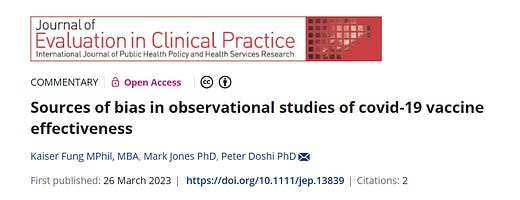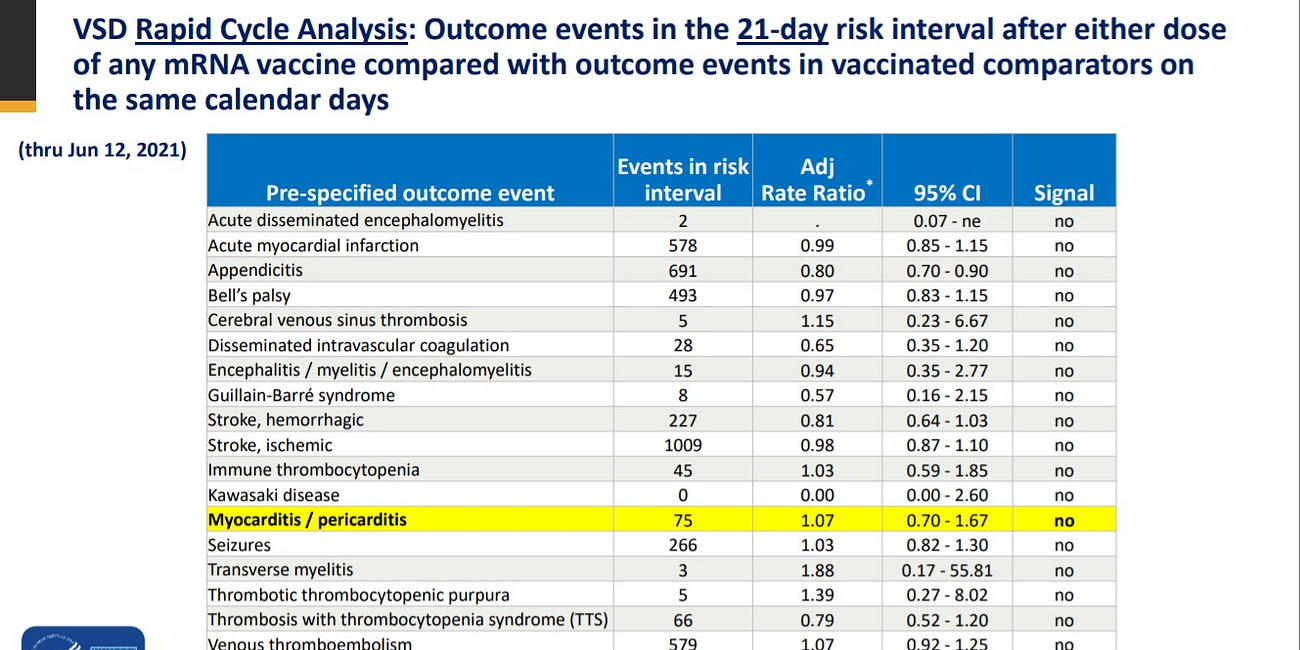This Second Most Important COVID19 Studies Bias, the Lyons-Weiler/Fenton/Neil Bias, is Confirmed as "Case-Counting Window Bias"
The medical literature acknowledged this obvious, elementary bias that everyone in my community has known about since January 2021. Attribution matters.
I was surprised to see this from Vinay Prasad last night:
He points to a new paper by Peter Doshi et al. (Fung et al, 2023) addressing the now well-known bias in vaccine efficacy estimation related to the case-counting window. They noted that during pivotal COVID-19 vaccine trials, the primary endpoint was lab-confirmed symptomatic COVID-19. However, cases were only counted starting 14 days (7 days for Pfizer) after the completion of the dosing regimen, a period referred to as the “fully vaccinated” time point. The exclusion of cases before this period was not justified in trial protocols, though a Pfizer post-marketing document suggested that the vaccine needs time to stimulate the immune system during this early period, an ad-hoc justification that nevertheless does not undo the bias.
This counting method is actually problematic even when the window is applied symmetrically to both vaccine and placebo groups; obviously, if all of the cases fell into the vaccinated before day 1 of counting, the negative efficacy would not be detected.
In cohort studies, this window is only applied to the vaccinated group since unvaccinated individuals do not receive placebo shots. This asymmetry can lead to a biased estimate, making a completely ineffective vaccine appear effective. For example, Doshi et al. illustrated that in a hypothetical scenario using data from the Pfizer Phase III trial, an ineffective vaccine could appear 48% effective due to this bias.
I reported very early (January 2021) that the original claim of 95% efficacy was, in fact (not in theory), vastly inflated by this very bias. By re-analyzing the Pfizer clinical trial data, I re-estimated efficacy to be 75.4% when cases dropped from the analysis were re-included.
In the January 2021 article, entitled “Discrepancies in Moderna’s FDA Report Demand Answers”, published in Children’s Health Defense The Defender, I offered the following analysis:
“In contrast to what Moderna reported to the U.S. Food and Drug Administration (FDA) in the early months of COVID-19, its mRNA vaccine is not an established technology. It is new. As a new, experimental vaccine, it deserves close and objective scrutiny.
Moderna reports 94.5% efficacy. The “efficacy” of vaccines is understood to be a measure of the effectiveness of the vaccine on an ideal population, and differs from “effectiveness,” which is how well a vaccine manages to induce evidence of immunity in the real population upon which it is being used.
Moderna reported to the FDA (Zhang, 2020) efficacy as the ratio of the rate of SARS-CoV-2 infection in the vaccinated (16 infected out of 28,068 vaccinated) to the rate of infection in the placebo group (275 infected out of 27,956 given placebo).
Close inspection of Moderna’s data made public ahead of the FDA’s Vaccines and Related Biological Products Advisory Committee (VRBAC) meeting that was scheduled for Dec. 17, 2020, however, reveals that among the vaccinated, an additional 81 participants and 118 among the placebo participants developed a COVID-19 diagnosis between the first and second shots. These participants were determined to be ineligible for the second dose and removed from the study.
By my calculations, these additional cases shift the vaccine efficacy from 94.5% to 75.4%.
If a chemotherapy agent is being tested against another cancer treatment, the deaths that occur between scheduled treatment rounds must be counted. It is misleading not to count these additional cases of COVID-19 in the Moderna vaccine trial — the 94.5% efficacy is not based in clinical reality even for an ideal population.”
Norm Fenton and Martin Neil then later on realized the same bias, and their analyses concluded that the bias would lead to high efficacy even for random data. You can see their “cheap trick” article cited below.
Fung et al. should publish a corrigendum and attribute my discovery of this already widely known bias in this context, and Fenton and Martin Neal's realization of the bias's impact on an ineffective vaccine.
The first most important bias, of course, is case identification via non-quantitative PCR using no internal negative control and instead relying on arbitrarily high cycle threshold values. This bias makes all studies that used this odd form of PCR, never used to my knowledge in studies before, potentially invalid. The case identification bias built into CDC’s protocol beyond the PCR was also identified and published in a monograph by IPAK.
Why, you might ask, didn’t you publish these early beacons of light in the peer-reviewed literature? The answer is obvious: We tried, but during COVID mania, the journals would not touch anything close to objectivity about the virus, the flaws in the RCTs, the flaws in the retrospective epidemiological studies.
This matters. Issues like this have caused me to create, with many others, The World Society for Ethical Science and the journal Science, Public Health Policy & the Law (to be relaunched very, very soon with a massive overhaul in the interface). We need a safe conduit for objective science if we are to respond in real-time and be effective against pandemonium.
Your membership in WSES can support the journal's relaunch (coming very soon!). Join us, and let the public's need for objective science return.
Citations
Fung K, Jones M, Doshi P. Sources of bias in observational studies of covid-19 vaccine effectiveness. J Eval Clin Pract. 2024 Feb;30(1):30-36. doi: 10.1111/jep.13839. Epub 2023 Mar 26. PMID: 36967517.
How The Definition of "Fully Vaccinated" Misleads People on COVID-19 Vaccine Safety & Efficacy: An Explanation For CNN's Drew Griffin (substack.com)
Fenton and Neil’s Vaccine efficacy 'cheap trick' by exclusion (substack.com)









The entire issue is moot. There is no clinical definition of someone claimed to be ‘infected by Covid’. A mish-mash of observable symptoms - fever, high temp, fatigue etc - is just assumed to indicate Covid infection. But these symptoms can arise from a number of sources. Attribution to something claimed to be Covid is 100% dependent on the results of the fraudulent PCR test. This cannot diagnose ANYTHING. What it counts is conveniently assumed to be the result of Covid… convenient, that is, to those pushing the ludicrous and dangerous ‘vaccination’ strategy (looking at you Big Pharma), but you can get the same results ‘testing’ papaya fruit or any number of objects. Discussions about thresholds are akin to discussing how many angels can dance on a pinhead: irrelevant and meaningless, but conveniently sustaining the dangerous myth that the PCR test would be meaningful if applied properly.
A classic! Be sure to read the whole ‘series’: https://okaythennews.substack.com/p/science-summary-covid-19-vaccines